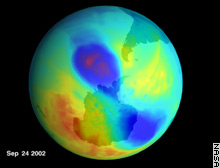This year's hole was also much smaller than last year's hole. The scientists at NASA say that these are random weather conditions and not a long-term trend

Like a large amoeba in the sky, the hole in the ozone over Antarctica split into two parts that moved very far from the southern continent. The surprising development is the first of its kind since NASA and other American federal agencies began monitoring the ozone hole, an area of thin ozone high in the atmosphere - more than twenty years ago.
Satellite images taken during 2002 also revealed that the ozone hole had shrunk compared to the previous two years. "We first encountered this split in early September," says Craig Long, a meteorologist at the National Oceanic and Atmospheric Administration (NOAA). According to him, weather disturbances in the stratosphere are responsible for this split. What's more, the hole also shrank in size before the split because of warm temperatures in the atmosphere, says Paul Newman, a NASA ozone scientist.
The stratosphere extends from a height of 10 km to a height of about 50 km above the earth's surface. This layer contains high concentrations of ozone that protect the earth from the harmful ultraviolet radiation of the cosmic rays. This radiation can lead to the proliferation of skin cancer. In fact, without this layer we could not exist. Since the XNUMXs, balloons, satellites and ground stations have been measuring the temporary ozone hole over Antarctica for five years during the Southern Hemisphere's winter and spring—our summer and fall.
Between the years 1996 and 2001, the hole reached an area of 24 million square kilometers - an area larger than the continent of Antarctica. As of early September 2002, the seasonal hole has dwindled to an area of only 15 million square kilometers. The air over the South Pole becomes the coldest in August and September. The freezing weather calls for the creation of thin clouds, and the chemicals emitted by the industrialized countries swallow the ozone molecules. By October, the air warms and the hole disappears. The scientists say that the September 2002 trend may be coincidental and caused by temporary weather patterns and does not necessarily reflect a long-term trend, say NOAA and NASA scientists.
